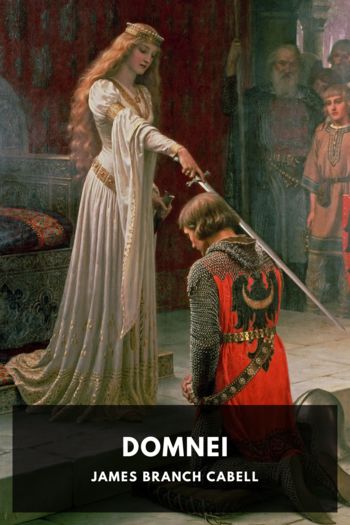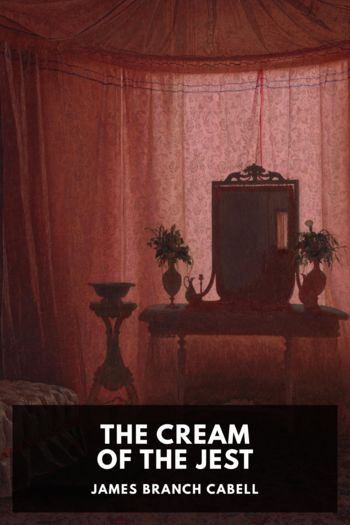Domnei James Branch Cabell (books to read as a couple TXT) 📖

- Author: James Branch Cabell
Book online «Domnei James Branch Cabell (books to read as a couple TXT) 📖». Author James Branch Cabell
I think he did not speak because there was no scope for words. I know that he knelt (incurious for once of victory) before this stranger who was not the Melicent whom he had sought so long, and that all consideration of a lost young Melicent departed from him, as mists leave our world when the sun rises.
I think that this was her high hour of triumph.
Caetera Desunt
The AfterwordThese lives made out of loves that long since were
Lives wrought as ours of earth and burning air,
Was such not theirs, the twain I take, and give
Out of my life to make their dead life live
Some days of mine, and blow my living breath
Between dead lips forgotten even of death?
So many and many of old have given my twain
Love and live song and honey-hearted pain.
Thus, rather suddenly, ends our knowledge of the love-business between Perion and Melicent. For at this point, as abruptly as it began, the one existing chronicle of their adventures makes conclusion, like a bit of interrupted music, and thereby affords conjecture no inconsiderable bounds wherein to exercise itself. Yet, in view of the fact that deductions as to what befell these lovers afterward can at best result in freehanded theorising, it seems more profitable in this place to speak very briefly of the fragmentary Roman de Lusignan, since the history of Melicent and Perion as set forth in this book makes no pretensions to be more than a rendering into English of this manuscript, with slight additions from the earliest known printed version of 1546.
IIM. Verville, in his monograph on Nicolas de Caen,2 considers it probable that the Roman de Lusignan was printed in Bruges by Colard Mansion at about the same time Mansion published the Dizain des Reines. This is possible; but until a copy of the book is discovered, our sole authority for the romance must continue to be the fragmentary MS. No. 503 in the Allonbian Collection.
Among the innumerable manuscripts in the British Museum there is perhaps none which opens a wider field for guesswork. In its entirety the Roman de Lusignan was, if appearances are to be trusted, a leisured and ambitious handling of the Melusina legend; but in the preserved portion Melusina figures hardly at all. We have merely the final chapters of what would seem to have been the first half, or perhaps the first third, of the complete narrative; so that this manuscript account of Melusina’s beguilements breaks off, fantastically, at a period by many years anterior to a date which those better known versions of Jean d’Arras and Thuring von Ringoltingen select as the only appropriate starting-point.
By means of a few elisions, however, the episodic story of Melicent and of the men who loved Melicent has been disembedded from what survives of the main narrative. This episode may reasonably be considered as complete in itself, in spite of its precipitous commencement; we are not told anything very definite concerning Perion’s earlier relations with Melusina, it is true, but then they are hardly of any especial importance. And speculations as to the tale’s perplexing chronology, or as to the curious treatment of the Ahasuerus legend, wherein Nicolas so strikingly differs from his precursors, Matthew Paris and Philippe Mouskes, or as to the probable course of latter incidents in the romance (which must almost inevitably have reached its climax in the foundation of the house of Lusignan by Perion’s son Raymondin and Melusina) are more profitably left to M. Verville’s ingenuity.
IIIOne feature, though, of this romance demands particular comment. The happenings of the Melicent-episode pivot remarkably upon domnei—upon chivalric love, upon the frauendienst of the minnesingers, or upon “woman-worship,” as we might bunglingly translate a word for which in English there is no precisely equivalent synonym. Therefore this English version of the Melicent-episode has been called Domnei, at whatever price of unintelligibility.
For there is really no other word or combination of words which seems quite to sum up, or even indicate this precise attitude toward life. Domnei was less a preference for one especial woman than a code of philosophy. “The complication of opinions and ideas, of affections and habits,” writes Charles Claude Fauriel,3 “which prompted the chevalier to devote himself to the service of a lady, and by which he strove to prove to her his love and to merit hers in return, was expressed by the single word domnei.”
And this, of course, is true enough. Yet domnei was even more than a complication of opinions and affections and habits: it was also a malady and a religion quite incommunicably blended.
Thus you will find that Dante—to cite only the most readily accessible of medieval amorists—enlarges as to domnei in both these last-named aspects impartially. Domnei suspends all his senses save that of sight, makes him turn pale, causes tremors in his left side, and sends him to bed “like a little beaten child, in tears”; throughout you have the manifestations of domnei described in terms befitting the symptoms of a physical disease: but as concerns the other aspect, Dante never wearies of reiterating that it is domnei which has turned his thoughts toward God; and with terrible sincerity he beholds in Beatrice de’Bardi the highest illumination which Divine Grace may permit to humankind. “This is no woman; rather it is one of heaven’s most radiant angels,” he says with terrible sincerity.
With terrible sincerity, let it be repeated: for the service of domnei was never, as some would affect to interpret it, a modish and ordered affectation; the histories of Peire de Maënzac, of Guillaume de Caibestaing, of Geoffrey Rudel, of Ulrich von Liechtenstein, of the Monk of Pucibot, of Pons de Capdueilh, and even of Peire Vidal and Guillaume de Balaun, survive to prove it was





Comments (0)